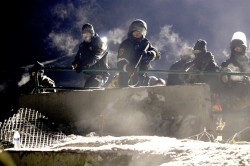News | January 24th, 2017

CANNON BALL - Around the time Standing Rock’s first camp was pitched against the Dakota Access Pipeline, a deadly poison was spread across thousands of acres in the area by a rancher intent on killing prairie dogs.
Six eagles, a buffalo, prairie dogs, and an antelope may have died because of the poison, investigators from the United States Environmental Protection Agency and the Standing Rock Sioux Tribe report. Questions have arisen as to whether humans who traveled to the area last year, now suffering from what is known as the “DAPL cough,” also were affected.
More than 40,000 pounds of the poison Rozol Prairie Dog Bait, an anticoagulant rodenticide, were purchased by rancher David Meyer, of Flasher, North Dakota, and a portion was spread across more than 5,408 acres of pasturelands, including the Wilder Ranch and the Cannonball Ranch, according to the United States Environmental Protection Agency.
In early April 2016, investigators spotted the bright bluish poison spread across large areas of pastureland, according to the United States Environmental Protection Agency.
Rozol is manufactured by Liphatech Inc., and has as its most active ingredient chlorophacinone, which if ingested or inhaled causes a slow, painful death by internal bleeding, according to the United States Environmental Protection Agency. The poison is also deadly to humans if consumed.
More than 20,000 people from 350 indigenous tribes from across the world passed through the camps setup by the Standing Rock Sioux Tribe against the Dakota Access Pipeline since August 2016. Some environmental watchdogs are concerned the poison was spread to people through ingestion of bison meat, as many activists complain of bloody noses, fatigue, and in some cases coughing up blood. The symptoms are referred to colloquially as the “DAPL cough,” according to a January 23 press release from Save the Buffalo Nation, the operating arm of the nonprofit environment advocate Mother Earth Trust.
Standing Rock’s first camp, the Sacred Stone Camp, began April 1, and the poison was spread at approximately the same time, Standing Rock Sioux Director of Environmental Development Allyson Two Bears said.
“But not anywhere near any of the camps,” Two Bears said. “There was some acreage that was applied on the Cannonball Ranch.” Two Bears wasn’t sure if the poison was spread across 20 parcels of the ranch land sold to Energy Transfer Partners last October, and which was also the location where private security hired by Frost Kennels illegally used dogs to attack activists.
“It was misapplication, so there was a cleanup that was done, and it was remediated before the main camp was set up,” Two Bears said.
“There are some misconstrued facts. There was 40,000 pounds purchased by the Meyer Ranch, but not all of it was applied.” Most of the poison was spread in areas of South Dakota, with a smaller portion on the Cannonball Ranch.
The closest activists came to the poison was on September 3, the day of the attack dogs. Two Bears said it would be nearly impossible for any humans to have been affected by the poison.
“You would literally have to eat it in order for it to be a lethal dose to you. I imagine you would have to eat a large quantity of it.”
Many nearby ranches donated bison and other meat to the camp last year, Two Bears said.

“By no means… there are no connections between any of the bison that were donated or provided to the camp throughout the summer. None of the animals that were involved… were exposed to any of the sites.
“I want to squash that fear now -- none of the bison that were donated to the people at the camps were from any of these ranches.”
State investigators and politicians including Congressman Kevin Cramer, R-N.D., have also pointed fingers at Standing Rock and the tribe’s supporters over the disappearance of cattle and buffalo from the area.
“I know some of the information about cattle disappearances,” Two Bears said. “And I question the integrity of those reports. It’s all been a part of the story that they are trying to write out to paint the picture of protectors being bad people.
“There are planes flying over daily. If this many bison were killed at the camp, it would not go unnoticed.” The case of missing cattle and bison is still under investigation by the North Dakota Stockmen’s Association.
The narrative local authorities and state politicians are trying to paint stems from recent corruption at the state’s highest ranks, Two Bears said.
“It goes completely against North Dakota values. We have been corrupt for several years now just because of the oil development here in North Dakota and what that brings.”
Meyer faces hefty fines for the misapplication of the poison, but the case is still in litigation, Two Bears said. Meyer could not be reached for comment.
Standing Rock’s other issues
On Tuesday, President Trump signed three executive orders pertaining to oil pipeline infrastructure.
“Something that has been in dispute,” Trump said before signing the Keystone Pipeline executive order. “We’re going to renegotiate some of the terms, and if they like, we’ll see if we can get that pipeline built. A lot of jobs, 28,000 jobs, great construction jobs.”
He signed the order, and then turned to the Dakota Access Pipeline executive order. “Again, subject to terms and conditions to be negotiated by us,” Trump said.
Attorney Chase Iron Eyes spoke on CBS News pertaining to President Trump’s executive orders.
“It’s clear that Donald Trump is going to represent some of the corporate interests that are seeking to privatize and further stratify the economic injustice that is happening right now on the ground in the state North Dakota in the most significant struggle we feel since the Civil Rights era, since the armed Wounded Knee occupation, since the Occupy Movement. Now he’s signaling that he’s willing to take it to the next level.
“It’s something that we on the ground anticipated, but it’s going to become a stark and harsh reality, and we are prepared for the fight because we feel that Americans need to stand up for clean water and to determine our own destiny. Standing Rock is going to become a focal point for all of these struggles.”
Two Bears is concerned about President Trump’s projected policies pertaining to energy infrastructure and environmental issues, including a possible freeze on environmental protection grants.
“There’s a big fight coming,” Two Bears said. “With this and the administration that’s coming in, we could very well be looking at cuts in essential programs like pesticides that work with applicators that could avoid situations like misapplications. We have to ensure programs are still there and this administration keeps these programs and regulations in order like the US EPA so we can ensure we have the health and safety of everybody. Had we not had the EPA and the pesticide program, we would not have had the route to perform an investigation and ensure that there would not be further exposure.”
Although Standing Rock won victories on December 4 when the U.S. Army Corps of Engineers halted Energy Transfer Partners’ drilling under the Missouri River at Lake Oahe and then registered its Environmental Assessment Impact study on January 18, Standing Rock Sioux Tribe Chairman Dave Archambault II issued a deadline for all activists to leave the Standing Rock area by January 30. Services, including ports potties, have been cancelled.
“Yesterday the tribe passed a resolution brought forward by the Cannon Ball District which asked that no camps remain in the Cannonball District,” Archambault said. “For this reason, we ask the protectors to vacate the camps and head home with our most heartfelt thanks. Much work will be required to clean up before the spring thaw, which will flood the area. It is imperative we clean the camps and restore them to their original state before this flooding occurs.”
LaDonna Tamakawastewin Allard, an owner of the Sacred Stone Camp lands, refused to move.
“The DAPL supporters betrayed by our own people,” she said in a Facebook post.
Iron Eyes, who ran for congress against Cramer last year, said people at the camps are “on edge.
“If you can, come out here,” Iron Eyes said on Tuesday. “We need you. It’s much easier to fight the most powerful empire on earth without a war chest, than your own people with all the money in the world.”
There are still up to 500 remaining people in the camps, Iron Eyes said. “Out there in pop media it appears the struggle is over, the tribe has asked people to leave, but hundreds of us have vowed to stay.”
Funds raised by Standing Rock Tribe over the past six months have been spent on rebuilding the tribe’s economy, particularly with investments focused on jobs, youth, and elder programs, the Standing Rock Sioux Tribe Council reported.
“Due to Morton County’s blocking of the bridge and the significant drop in tribal business revenues, as well as incurred expenses, we are facing a difficult time financially. While this movement benefits native rights nationwide especially regarding infrastructure projects, at this time, our Tribe has borne the brunt of the cost.”
Although Archambault and Governor Doug Burgum have met to discuss issues, Archambault said that the state’s true agenda is clear.
“The state claims they want to work closely with the tribe on repairing our relationship with them,” Archambault said. “Clearly that is not happening when legislation that impacts us is being drafted without consultation, consent or even basic communication.”
During the state’s legislative assembly in January, the Peace Garden State postponed House Bill 2154, or North Dakota Medical Marijuana Initiative, and introduced other bills including House Bill 1203, hoping to legalize the unintentional running down and killing of individuals obstructing vehicular traffic on public roads, House Bill 1151, which would exempt oil companies from reporting spills less than 420 gallons, House Bill 1304, which attempted to make illegal the wearing of ski masks on public roads in North Dakota, and Senate Bill 2315, an act that proposes the legalization of killing a violent intruder even if escape was possible or when trying to escape arrest after committing a violent felony.
December 16th 2025
November 14th 2025
October 13th 2025
October 13th 2025
October 6th 2025
_(1)__293px-wide.png)
_(1)__293px-wide.jpg)
__293px-wide.jpg)

_(1)__293px-wide.jpg)
_(1)_(1)_(1)__293px-wide.jpg)